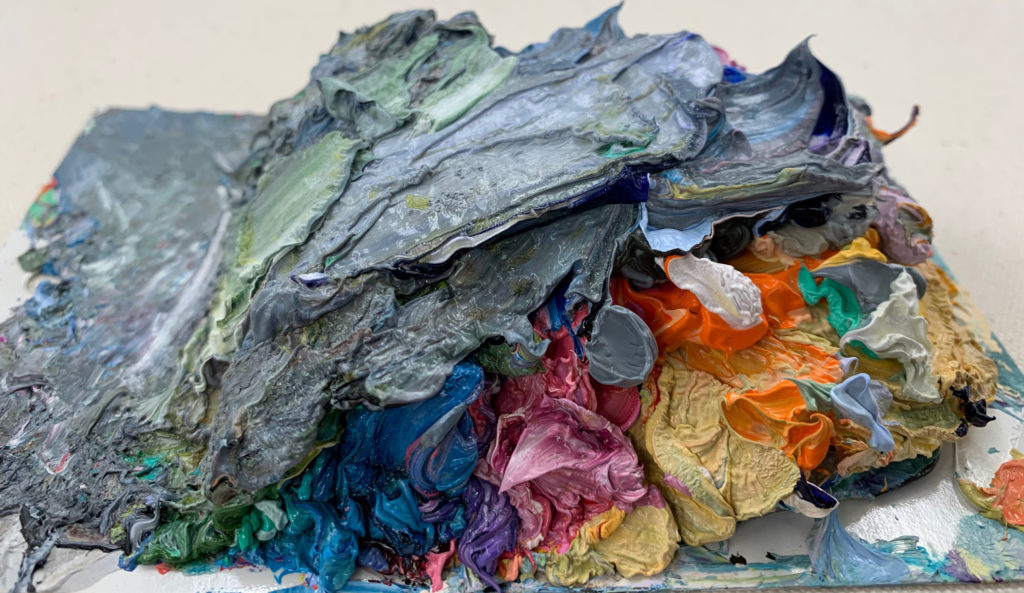Editor’s Note:
Added April 26, 2022
For some time, our recommendation for artists using oils over acrylic has been to work over harder, matte acrylic surfaces and avoid working on softer gels and gloss products. Our intention was to optimize the level of adhesion that would be achieved on a toothier surface as well as avoid the potential for future cracking as the oil paints become more brittle. While we have not seen adhesion problems of oils on any type of acrylic, recent testing has shown the potential for cracking in certain instances and conditions when applying artist oils over all of the many brands of glossy acrylics we have tested. While we have not received notice from artists of this phenomenon, we are able to repeat this specific type of cracking in our Lab.
Please visit https://justpaint.org/revising-our-recommendations-for-using-oils-over-acrylics/ for an overview of our testing, results and updated recommendations for applying oil colors over acrylics.
The EuACA’s Technical Committee has put together a document with best practice advice for oil painters working in thick layers. We are pleased to share this document so more artists can access this information. We have added links to relevant Just Paint articles and application sheets at the bottom of this page. The European Artists’ Colours Association (EuACA) is part of the European Council of the Paint, Printing Ink and Artists’ Colours Industry (CEPE). CEPE represents the interests of companies, including Golden Artist Colors, in regulatory matters in the EU. The CEPE is a non-profit international association based in Brussels, Belgium. We hope you find this information helpful. If you have any questions or comments, please contact [email protected] or call 800-959-6543.
European Artists’ Colours Association
Best Practice Recommendations – Impasto Painting With Oil Colours
The drying of oil paints involves the oxidation (oxygen uptake) and cross linking of the oil component within the paint to form a stable film. An additional stimulus to drying can be exposure to light and the photochemical reactions that result. All commonly used artist oil paints – such as those based on linseed oil, sunflower oil, walnut oil, safflower oil or poppy oil will dry in this manner.
Oil paint will not present drying problems when applied in the time-tested traditional manner of reasonably thin layers with the use of appropriate intermediate drying times. As the drying of oil paints is heavily dependent on the availability of oxygen and to some extent light it is unsurprising that when thick multiple layers of paint are applied, such as during the creation of certain impasto artwork, the outer layer can dry leaving a partially dried or fluid layer underneath. Furthermore, incorrect building of layers can lead to cracking and wrinkling of the surface. Such effects can have significant detrimental implications for the conservation of artwork.
It is possible to create thicker impasto artwork using without issues such as cracking, wrinkling and paint seepage (sometimes referred to as liquefaction) occurring. This brief document has been put together to provide recommendations on how to make the most of the multiple materials available in order to achieve this.
- Surface Preparation – Build A Strong Foundation
Prepare the canvas with a high quality primer that is high in pigment loading and has good strength when dry to accommodate the subsequent layers. Manufactures of artist paints will be able to advise on which from their range is most suitable for this purpose. For very heavy impasto work – texture pastes are available to create the necessary strong foundation.
- Layer Building – Target Increasing Flexibility
As the layers are built is very important that you target increasing flexibility as you proceed. Each layer should be more flexible than the one it is applied to. A large number of mediums are available for you to achieve this and manufacturers of artist paints and mediums will be able to advise you on their particular brands and which of their products are compatible with those of other brands.
- Consider Colour Drying Time
Different colours will have different drying times due to the difference in oil type used (Linseed vs. Sunflower or Safflower for example) and the differing nature of pigments. It is essential that slow drying colours are applied over fast drying colours. Applying a fast drying colour over a slower drying colour will prevent the access of oxygen to the under layer leading to incomplete or poor drying through the layers. Applying a fast drying colour over a slow drying colour will also lead to cracking. Artist oils manufacturers should be able to provide you with information on the relative drying time of their oil colours.
- Storage & Varnishing
Storing artwork in areas of high humidity is known to promote hydrolysis reactions of chemically fragile paint. Whilst drying it is important to store the artwork in cool and dry rooms. Varnishing of any oil painting should not take place until the works is completely dry.

